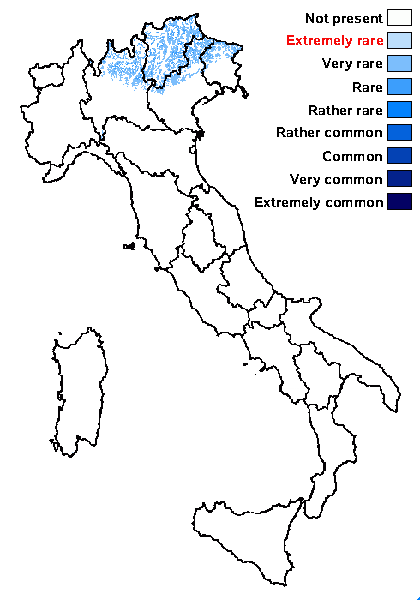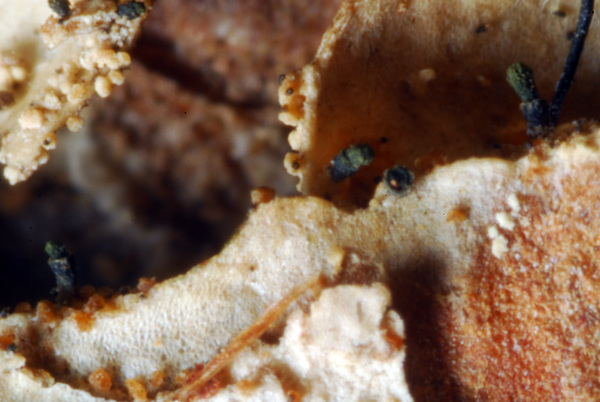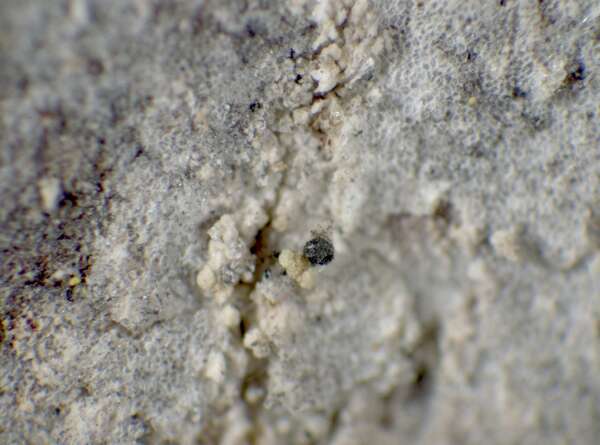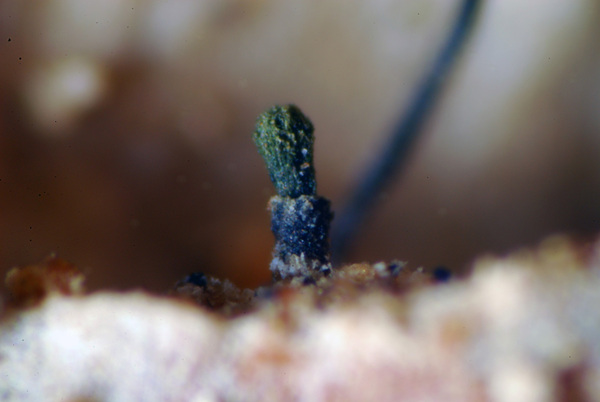Microcalicium disseminatum (Ach.) Vain.
Acta Soc. Fauna Fl. Fenn., 57, 1: 77, 1927. Basionym: Cyphelium disseminatum Ach. - K. Vetensk.-Akad. Nya Handl.: 227, 1817.
Synonyms: Calicium atomarium Fr.; Calicium disseminatum (Ach.) Fr.; Calicium microcephalum var. patelliforme Schaer.; Calicium subpedicellatum Schaer.; Calicium viridulum (Ach.) Fr.; Cyphelium atomarium Ach.; Cyphelium viridulum Ach.; Microcalicium subpedicellatum (Schaer.) Tibell; Strongylopsis commixta Vain.; Strongylopsis discreta Nádv.; Strongylopsis leucopus Vain.; Strongylopsis stichococci Vain.
Distribution: N - Frl (Puntillo & Puntillo 2009, Brackel 2016), Ven (Nascimbene 2008c, Puntillo & Puntillo 2009, Brackel 2016), TAA (Nascimbene 2006c, 2008b, 2013, 2014, Nascimbene & al. 2007b, Puntillo & Puntillo 2009, Nascimbene & al. 2009, 2010, 2014, Nascimbene & Marini 2015, Brackel 2016, Trindade & al. 2021), Lomb (Puntillo & Puntillo 2009, Brackel 2016).
Description: Thallus not evident, not lichenized. Apothecia short-stalked to subsessile, 0.1-0.2 mm high, the stalk black, of irregularly interwoven hyphae. Capitulum broadly cylindrical to lenticular, 0.1-0.3 mm across. Exciple well-developed, greenish in section, K+ brown; mazaedium well-developed, markedly protruding and often column-like, green-black, with sclerotized, persisting paraphyses. Asci 8-spored, broadly ellipsoid, formed in chains from ascogenous hyphae lacking croziers, with a single functional wall layer, deliquescing at maturity. Ascospores 1-3(-5)-septate, ellipsoid to subcylindrical, 11-13 x 3-4 µm, with a distinct ornamentation of spirally arranged ridges. Pycnidia dark in upper part, pale in lower part, the wall blue-green, of thick-walled cells. Conidia hyaline, broadly ellipsoid to subglobose, 2-3 x c. 2 µm. Photobiont absent. Spot tests: K-, C-, KC-, P- (but the greenish pigments reacting K+ brown). Chemistry: without lichen substances.Note: on lignum and bark of both deciduous a coniferous trees, parasitic on calicioid lichens, especially Chaenotheca-species, with the conidiomata forming much earlier than the ascomata, or saprophytic on bark, lignum and algal colonies; probably more widespread in the Alps.
Growth form: Lichenicolous fungus
Substrata: bark
Reproductive strategy: mainly sexual
paras Caliciales
Commonnes-rarity: (info)
Alpine belt: absent
Subalpine belt: rare
Oromediterranean belt: absent
Montane belt: very rare
Submediterranean belt: absent
Padanian area: absent
Humid submediterranean belt: absent
Humid mediterranean belt: absent
Dry mediterranean belt: absent

Predictive model
Herbarium samples
Growth form: Lichenicolous fungus
Substrata: bark
Reproductive strategy: mainly sexual
paras Caliciales
Commonnes-rarity: (info)
Alpine belt: absent
Subalpine belt: rare
Oromediterranean belt: absent
Montane belt: very rare
Submediterranean belt: absent
Padanian area: absent
Humid submediterranean belt: absent
Humid mediterranean belt: absent
Dry mediterranean belt: absent

Predictive model
| Herbarium samples |
 Index Fungorum
Index Fungorum
 GBIF
GBIF






